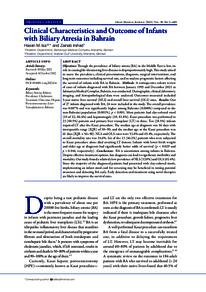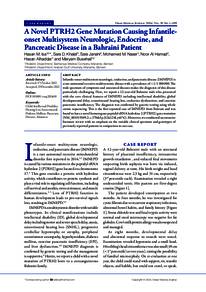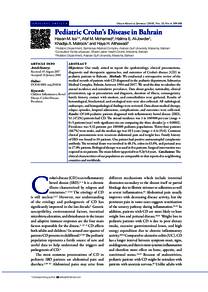Document
Clinical characteristics and outcome of Infants with Biliary Atresia in Bahrain.
Identifier
DOI 10.5001/omj.2023.64
Contributors
Irshad, Zainab., Author
Publisher
Oman Medical Specialty Board.
Gregorian
2023-03
Language
English
English abstract
Objectives: Though the prevalence of biliary atresia (BA) in the Middle East is low, its
role in causing life-threatening liver diseases is disproportionately high. This study aimed
to assess the prevalence, clinical presentations, diagnosis, surgical interventions, and
long-term outcomes including survival rate, and to analyze prognostic factors affecting
the survival of infants with BA in Bahrain. Methods: A retrospective cohort review
of cases of infants diagnosed with BA between January 1993 and December 2021 at
Salmaniya Medical Complex, Bahrain, was conducted. Demographic, clinical, laboratory,
imaging, and histopathological data were analyzed. Outcomes measured included
5-year native liver survival (NLS) and overall liver survival (OLS) rates. Results: Out
of 27 infants diagnosed with BA, 26 were included in the study. The overall prevalence
was 0.007% and was significantly higher among Bahraini (0.006%) compared to the
non-Bahraini population (0.001%), p < 0.001. Most patients had clay-colored stool
(19 of 22; 86.4%) and hepatomegaly (18; 81.8%). Kasai procedure was performed in
23 (88.5%) patients and primary liver transplant (LT) in three. Ten (38.5%) infants
required LT after the Kasai procedure. The median age at diagnosis was 56 days with
interquartile range (IQR) of 30–90, and the median age at the Kasai procedure was
61 days (IQR = 56–90). NLS and OLS rates were 53.8% and 65.4%, respectively. The
overall mortality rate was 34.6%. Six of the 13 (46.2%) patients who were subjected
to Kasai procedure alone died awaiting LT donors. Infants with lower birth weight
and older age at diagnosis had significantly better odds of survival (p < 0.029 and
p < 0.044, respectively). Conclusions: BA is uncommon among infants in Bahrain.
Despite effective treatment options, late diagnosis can lead to significant morbidity and
mortality. Our study found a relatively low prevalence of NLS (53.8%) and OLS (65.4%).
Since the majority of the diagnosed patients had presented with clay-colored stools,
implementing an infant stool card for screening may be beneficial in raising parental
awareness and detecting BA early. Early detection and treatment using novel therapies
are likely to improve the survival rates.
Member of
Resource URL
Category
Journal articles



